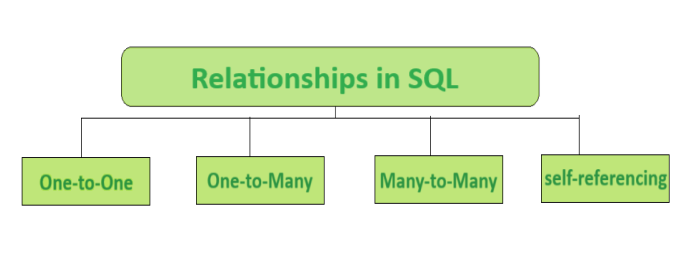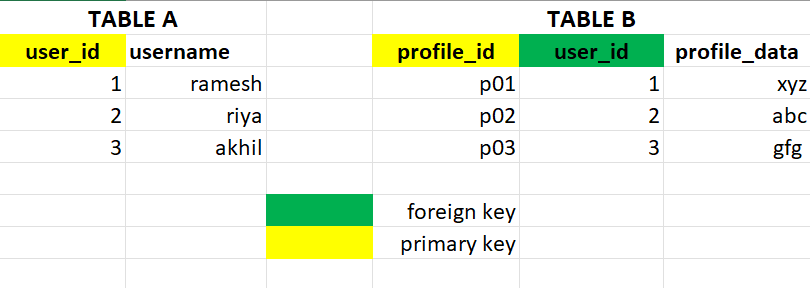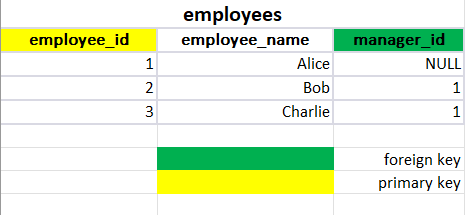
|
|
SQL (Structured Query Language) is a powerful tool used to communicate with and manage databases. Think of a database as a digital filing cabinet where you store information. Imagine a database as a digital filing cabinet where information is stored. SQL helps you interact with this filing cabinet, allowing you to perform tasks like adding, updating, retrieving, and deleting data. It acts as a universal database language, enabling you to ask questions such as “What are all the customers’ names?” or “How many products do we have in stock?” SQL’s structured format makes it easy for humans and computers to understand, making it an essential skill for anyone dealing with data management or analysis. In this article, we will see, How to select the last records in a one-to-many relationship using SQL join. Understanding Relationships in SQLRelationships in SQL refer to the associations or connections between tables in a relational database. These relationships are established using foreign keys, which are columns in a table that refer to the primary key in another table. Relationships help organize and structure data, allowing for efficient data retrieval and maintaining data integrity. There are different types of relationships: one-to-one, one-to-many, many-to-many, and self-referencing.  Relationships in SQL 1. One-to-One Relationship in SQL
Output:  one-to-one relatonship 2. One-to-Many Relationship in SQL
Output:  One-to-many relationship 3. Many-to-Many Relationship in SQL
Output:  Many-to-many relationship 4. Self-Referencing Relationship in SQLDefinition: A table has a foreign key that references its primary key. Setup: Include a foreign key column in the same table that references its primary key. For example : A table employees with a column manager_id referencing the same table’s employee_id. Output:  Self-Referencing Relationship SQL joinsA join is a mechanism that combines rows from two or more tables based on a related column between them. The purpose of using joins is to retrieve data from multiple tables in a single result set. The common columns used for joining tables are usually primary and foreign keys. There are several types of joins in SQL  SQL joins consider the following database,  Database There are several types of joins in SQL: 1. INNER JOINDefinition: Returns only the rows where there is a match in both tables based on the specified condition. Syntax: SELECT * Example: SELECT employees.employee_id, employees.employee_name, departments.department_name Output:  INNER JOIN output Explanation: The SQL query selects employee_id, employee_name, and department_name from employees and departments tables, joining them on department_id. It retrieves information about employees and their corresponding department names. 2. LEFT (OUTER) JOINDefinition: Returns all rows from the left table and the matching rows from the right table. If there is no match, NULL values are returned for columns from the right table. Syntax: SELECT * Example: SELECT employees.employee_id, employees.employee_name, departments.department_name Output: -JOIN-output.png) LEFT (OUTER) JOIN output Explanation: The SQL query uses a LEFT JOIN to retrieve employee_id, employee_name, and department_name from employees and departments, showing all employees and their associated department names, including those without a match. 3. RIGHT (OUTER) JOINDefinition: Returns all rows from the right table and the matching rows from the left table. If there is no match, NULL values are returned for columns from the left table. Syntax: SELECT * Example: SELECT employees.employee_id, employees.employee_name, departments.department_name Output: -JOIN-output.png) RIGHT (OUTER) JOIN output Explanation: The SQL query employs a RIGHT JOIN to fetch employee_id, employee_name, and department_name from employees and departments, displaying all departments and their corresponding employees, including unmatched departments without employees. 4. FULL (OUTER) JOINDefinition: Returns all rows when there is a match in either the left or the right table. If there is no match, NULL values are returned for columns from the non-matching table. Syntax: SELECT * Example: SELECT employees.employee_id, employees.employee_name, departments.department_name Output: -JOIN.png) FULL (OUTER) JOIN Explanation: The SQL query employs a FULL JOIN to retrieve employee_id, employee_name, and department_name from employees and departments, displaying all records from both tables, matching on department_id and including unmatched rows from both tables. How to Select the Last RecordsWhen dealing with a one-to-many relationship, selecting the last records often involves identifying the most recent entry for each parent record. Consider the following database,  Database Here are several methods to accomplish this: 1. Using Subquery with ‘LIMIT’ and ‘ORDER BY’Example: SELECT * Output:  Using Subquery with LIMIT and ORDER BY output Explanation: The above SQL query retrieves records from a parent-child relationship in a SQL database. It employs a subquery to find the latest child record for each parent based on the ‘created_at‘ timestamp. The main query then joins the parent and child tables, filtering the results to include only the rows where the child ID matches the one obtained from the subquery. This effectively selects the most recent child record for each parent in a one-to-many relationship, ensuring only the latest child entry per parent is included in the final result set. 2. Using Subquery with MAXExample: SELECT p.*, c.* Output:  Using Subquery with MAX output Explanation: The given SQL query retrieves the latest records from a one-to-many relationship between a “parent” and “child” table in a SQL database. It does so by joining the “parent” and “child” tables based on the common parent_id, and additionally using a subquery to identify the maximum created_at timestamp for each parent_id in the “child” table. The main join condition includes a comparison with the latest_child subquery, ensuring that only the rows with the maximum created_at for each parent_id are selected. The result set includes all columns from both the “parent” and “child” tables for the latest records in the one-to-many relationship. 3. Using Correlated SubqueryExample: SELECT p.*, c.* Output:  Using correlated subquery Explanation: In the given SQL query using a correlated subquery, it selects records from a one-to-many relationship between a parent and child table. The query retrieves all columns from the parent and child tables for rows where the child’s creation timestamp is the maximum within each group of children sharing the same parent. Essentially, it returns the latest child record for each parent based on the “created_at” timestamp, providing a concise way to obtain the most recent child entry for each parent in the relationship 4. Using ROW_NUMBER() Window FunctionExample: WITH RankedChild AS ( Output: -Window-Function-output.png) Using ROW_NUMBER() Window Function output Explanation: In the given example SQL query, the ROW_NUMBER() window function is used to assign a unique row number to each record in the result set based on the descending order of the “created_at” column within each partition defined by the “parent_id.” The query joins the “parent” and “child” tables on the “parent_id” and selects all columns from both tables along with the calculated row number. The final output, obtained by filtering rows where the row number (rn) is equal to 1, retrieves the latest records for each parent in a one-to-many relationship, effectively selecting the most recently created child record for each parent. 5. Using LEFT JOIN and IS NULLExample: SELECT p.*, c.* Output:  Using LEFT JOIN and IS NULL output Explanation: The given SQL query retrieves records from a one-to-many relationship between a “parent” table (denoted as p) and a “child” table (denoted as c). It uses a LEFT JOIN to match rows from the parent table with corresponding rows in the child table based on the parent_id. Additionally, it employs a self-join on the child table (c2) to identify the latest records by comparing their created_at timestamps. The WHERE clause ensures that only rows with no later child records (c2.parent_id IS NULL) are included, effectively selecting the latest records for each parent in the one-to-many relationship. ConclusionIn conclusion, Selecting the last records in a one-to-many relationship using SQL joins can be approached in various ways. You can use subqueries with By mastering these techniques, you can efficiently manage and retrieve data in complex relational databases, |
Reffered: https://www.geeksforgeeks.org
| Databases |
Type: | Geek |
Category: | Coding |
Sub Category: | Tutorial |
Uploaded by: | Admin |
Views: | 15 |